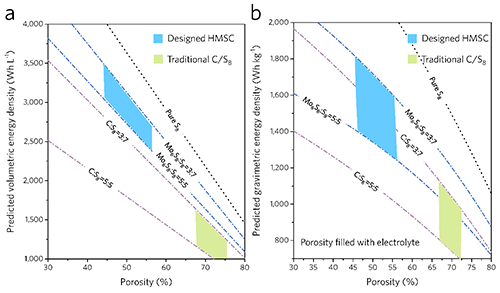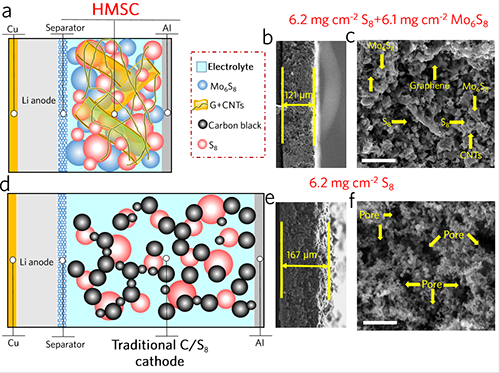Scientists proposed a new class of intercalation-conversion hybrid cathodes for Li-S full-cell architectures
Date:27-03-2019 Print
Anion-redox lithium-sulfur (Li-S) is one of the most promising conversion battery chemistries with high theoretical cathode energy density of 2600 Wh kg-1 based on the weight of elemental sulfur, S8 + 16e- + 16Li+ = 8Li2S, several times higher than conventional LIB cathodes based on transition metal cation-redox intercalation reactions. Unfortunately, due to the electronic insulating nature of the S8 and Li2S, the actual full-cell energy densities are a far cry from the theoretical values resulting from high cathode porosity (Li-S: >70 vol%, LIB: < 35 %) and the excessive use of inactive components such as a high electrolyte to active material ratio ( Li-S: >15 μL mg-1, commercial Li ion batteries (LIB): ~ 0.3 μL mg-1) and a high fraction of conductive carbons (Li-S: > 30 wt%, LIB: < 5 wt %).
In order to overcome this challenge, recently Prof. SUO Liumin from Institute of Physics, Chinese Academy of Sciences collaborated with Prof. LI Ju and Dr. XUE Weijing from MIT proposed a new strategy to design an intercalation-conversion hybrid cathode material by introducing electrochemically-active Chevrel-phase Mo6S8 with fast lithium intercalation reactions and high tap density to hybridize with S8. This material combination of Mo6S8 and S8 is akin to the relation between the primer and the TNT in explosives, with one fast igniting, and another having high gravimetric energy.
In the work, the HMSC containing only ~10 wt% carbon shows good rate capability to 6 mA cm-2 and stable long-term cycling performance. More importantly, the cathode porosity is tremendously reduced into less than 55 %, and an extremely low E/AM ratio of 1.2 μL mg-1 can be realized. Ah-level pouch cells is demonstrated successfully with high joint Eg and Ev of 366 Wh kg-1 and 581 Wh L-1, outperforming both the Li-S and the commercial LIB in joint energy densities.
This study entitled "Intercalation-conversion hybrid cathodes enabling Li-S full-cell architectures with jointly superior gravimetric and volumetric energy densities" was published on Nature Energy.
The study was supported by the National Science Foundation, the Ministry of Science and Technology of China, the Chinese Academy of Sciences.
 |
| Figure 1. Design strategy for jointly high gravimetric-volumetric energy density. (Image by XUE weijiang) |
 |
| Figure 2. Characterizations of the HMSC and traditional C/S8cathode. (Image by XUE weijiang) |
 |
| Figure 3. TheEgandEvof the Li//HMSC full cell. (Image by XUE Weijiang) |
Contact:
Institute of Physics
SUO Liumin
Email:suoliumin@iphy.ac.cn
Key word:
Lithium-sulfur batteries, hybrid cathode electrode, high energy density
Abstract:
A class of dense intercalation-conversion hybrid cathodes are proposed by combining intercalation-type Mo6S8 with conversion-type sulfur to realize a Li-S full cell. The mechanically hard Mo6S8 with fast Li-ion transport ability, high electronic conductivity, active capacity contribution and high affinity for lithium polysulfides is shown to be an ideal backbone to immobilize the sulfur species and unlock their high gravimetric capacity. Cycling stability and rate capability are reported under realistic conditions of low carbon content (~10 wt%), low electrolyte/active material ratio (~1.2 μL mg-1), low cathode porosity (~55 vol%) and high mass loading (> 10 mg cm-2). A pouch cell assembled based on the hybrid cathode and 2× excess Li metal anode is able to simultaneously deliver a gravimetric energy density of 366 Wh kg-1 and a volumetric energy density of 581 Wh L-1.


